I remember back when I was a kid in art classes, we would place our hands onto a piece of drawing paper, and trace the outline of the fingers with coloured pencils.
We would repeat it over and over again – with the other hand - until the whole piece of paper is filled with the outlines of our hands. Some were smooth, others were shaky.
I’d look at it with a satisfied smirk, submit it to the teacher and rush out to play with the other boys.
I never gave much thought to art classes as a little boy, which makes it ironic now that as a young man, I love to see ancient, tribal art. The Cuevas de las Manos (literally Caves of the Hands) in Argentinean Patagonia is just that: ancient artwork of hand outlines, yet the instance I knew about it, I went out of the way to see it.

There isn’t much information online and coupled with it being the off-season, tours are not as common. That isn’t gonna stop me; I welcome challenges that enrich me.
Located some 163km from the small town of Perito Moreno (not to be confused with the magnificent glacier of the same name) or a further one hour away from Los Antiguos, this UNESCO World Heritage Site is in the middle of nowhere.
(Why are UNESCO Sites always in the middle of nowhere?!)
Comparing my options, I decided to stay at Los Antiguos. I found an Airbnb host who kindly picked me up at the bus station and booked a private tour before I arrived.
Journey to Cuevas de las Manos (Caves of the Hands)
The first challenge came when the bus from El Calafate took 5 hours longer due to a road closure. To make matters worse, there isn’t WIFI and the area around these towns had very bad cellular reception, so I could hardly contact my host. A short window of opportunity opened at one of the stops along the 18.5 hours’ bus ride where I had cellular reception for 5min and I quickly sent an Airbnb message. She ended up still waiting for 2 hours at the bus terminal but she was in high spirits.
After a quick breakfast at her place, my driver Roberto picked me up and it was a long 2.5 hours’ drive to the Caves. I tried having a conversation in Spanish but I think I ran out of basic vocabulary. We listened to music and admired the scenery; passing by yellow-green shrubs, Lake Buenos Aires and lots of horses and guanacos (a type of llama common in Patagonia).
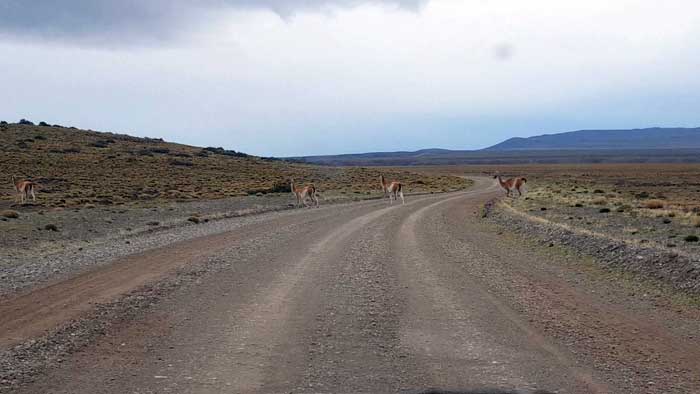
Why did the guanacos cross the road?
Along the famous Route 40 were small altars dotting the road and I asked Roberto what those were. He said in a solemn tone, “Accidents.”
I drifted in and out of sleep, when the smooth drive along the paved road turned into a bumpy and noisy gravel road drive 2 hours later. I saw a sign that says ‘Cuevas de las Manos’ with an arrow pointing left and I was excited. But in smaller prints were the words 28km.
Dreams dashed. Bubble burst. Excitement extinguished.
30 min later, we finally reached the reception centre: a small wooden hut tucked away in the Canyons of Rio Pinturas. The information centre had imperfect but passable English and a basic cafeteria.
My Private Tour
Entrance to the caves is at ARS $200/USD $12 (May 2017) and includes a roughly one hour guided tour. It was just me and my (thankfully) English-speaking guide Augustina. She said during the summer there are usually around 200 people per day, but on that fateful May afternoon at 4pm, I was the fourth visitor that day.
Whee, I got a private tour! Talk about value for money! It was like paying USD $12 for a history lesson – one that is actually interesting!
As we walked along the wooden platform overlooking the deep, scenic canyon and ventured into the cave’s interior, I felt like we stepped into an ancient world.
Four thousand years before the Egyptians had their hieroglyphs, seven thousand years before the creation of the first book, and nine thousand years before I drew my first hand-outlines, the early Patagonians were documenting their stories on the walls of these caves.
To be precise, the hand arts are outside of the caves on the stony overhangs and various rock shelves, and not inside the few caves that are there.
Sadly, some parts of the site had been vandalized by tourists and a metal fence now stands between you and the walls. Thanks to these irresponsible tourists, selfies don’t look as good now.
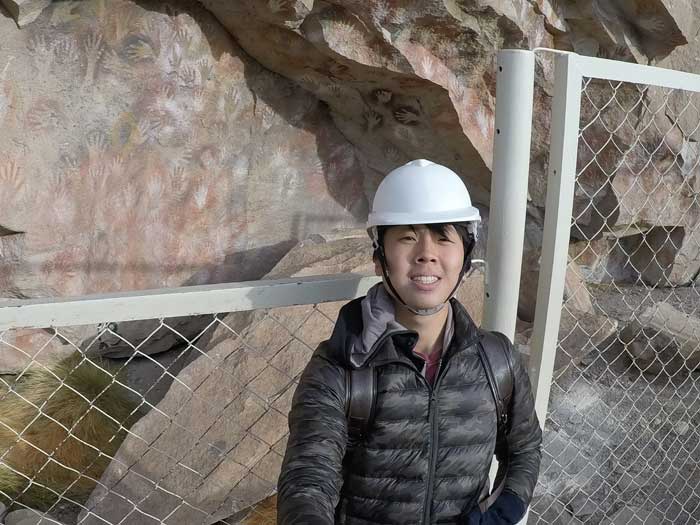
Bad selfie.
According to Augustina, these paintings were first discovered by a monk in 1941 and only seriously studied much later and declared a UNESCO site in 1999.
Wait, is the monk one of the stereotypical guru in the mountains?
She continued: the arts belong to three different cultures from three different generations of people.
Chapter 1 - The Hunt
The first and the oldest – dating back to 7300 BC – represents the early hunter-gatherers from postglacial times. They are the most interesting to me as they tell a story. Some scenes show an individual hunter and others show groups of 10 or more.
But they all depict hunting scenes deploying different strategies: ambushing, surrounding and using throwing weapons known as ‘bolas’. These bolas were made of weights on the ends of interconnected cords and were used to entangle the legs of their preys.
In one section of the wall, one canvass if you will, cracks in the rocks were used to represent ravines that the hunters chase the animals into. And directly opposite this canvass across the canyon are the actual ravines.
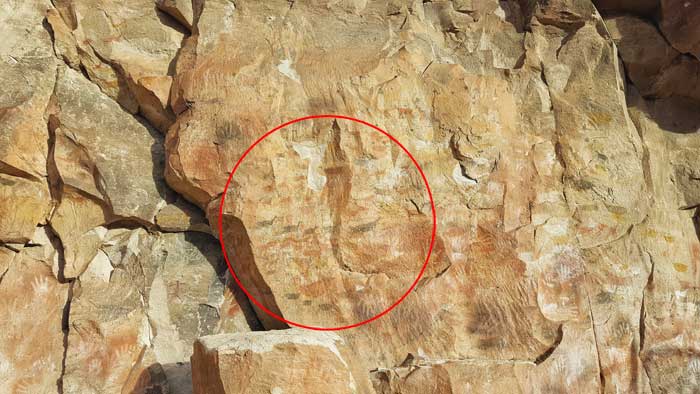
Circled in red are animal paintings
I looked at the painting, then turned to stare at the ravines. In my imagination, I see the hunters swinging their bolas above their heads, calling out their battle cries like Red Indians, while the guanacos run away and getting ambushed by another group of hunters.
Sneaky.
Beside guanacos, the other animals drawn were of lizards and spiders, pregnant and baby animals and even evil spirits. These unexplainable spirits of tribal art are what fascinates me the most. I feel that it represents the tribe culture and their fears, and is what makes a tribe unique.
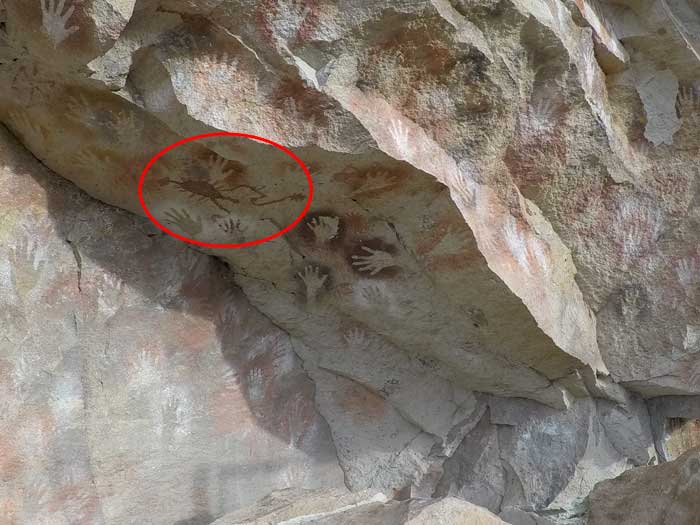
Who's that Pokemon?
Chapter 2 - Hands
We continued towards the second group of paintings.
“This is where you see the photos all over the internet,” Augustina said. “The most photographed part of the caves.”

In front of us were hundreds of stencilled imprints of human hands - roughly the size of adolescent males - in all sorts of red, yellow and orange hues. They look like the ones I did back in art class!
I kid. (Pun intended)
Augustina went on to explain that these ancient artists used blow pipes to spray mineral pigments over their hands, creating something of an airbrush effect that worked out well on the jagged stone walls. In other words, they were negative painted.
They used different mineral pigments for the different colours: iron oxides for red and purple, kaolin for white, natrojarosite for yellow, and manganese oxide for black.
They look basic but if you consider the fact that these hand paintings date back to 5000 BC, and were created from such technology and knowledge, you gotta be impressed!
Of the over 800 hand imprints, only 31 are of right hands, which suggests that most of the painters held the blow pipe with their right hands. One had six fingers, I kid you not.
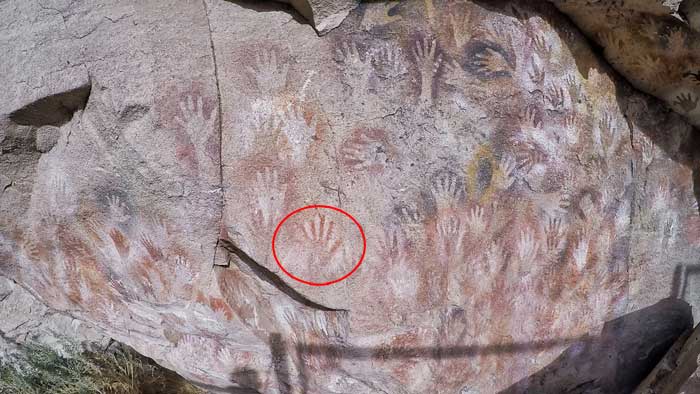
Do you see the 6 fingers?
But even more exclusive than the six-fingered hand is an imprint with a circle around it, like an aura. It could belong to a shaman or a tribal chief, nobody knows. Or maybe… an alien.
The winds harassed us as we walked further into the canyon. My helmet got knocked off twice by the invisible force of nature.
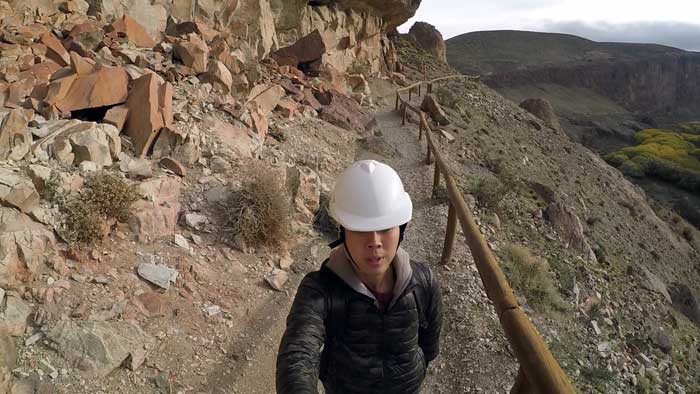
Chapter 3 - Abstract
The third generation of paintings were abstract designs. The ancient Picassos drew geometric shapes, zigzag patterns and representations of the sun and stars. The red dots on the ceilings were probably made by first submerging the bolas in pigments then throwing onto the ceilings.
This site was last inhabited by possibly the ancestors of the Tehuelche people, 700 AD. As nomads, they leave when their main food source became scarce.
“If they were nomads,” I asked Augustina, “Then why aren’t these paintings found in other places?”
“They are found in nearby caves and throughout Patagonia, but in smaller numbers. This is the place with the most concentrated number of paintings.”
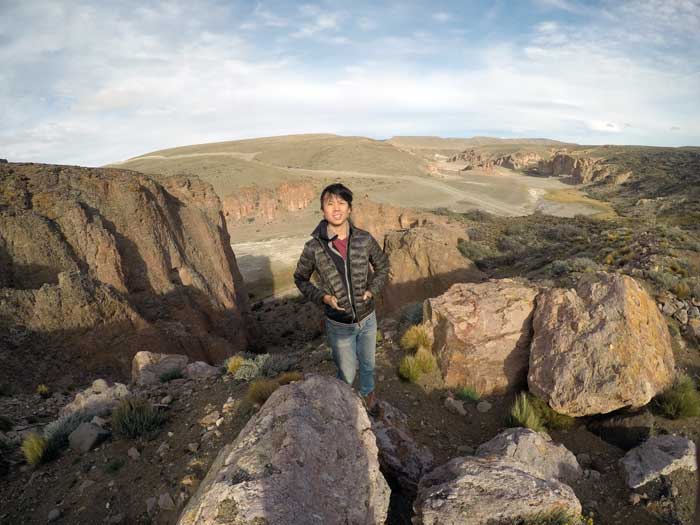
As we turned back towards the reception centre, a condor flew above into the descending sun. It was a fitting end to the well-explained tour. I turned back for one last look at the paintings and noticed how fresh and bright they still looked. Nature helped preserved these paintings by providing low humidity in the area.
Was it worth it? On face value, no. You’ll need to go to remote towns, find a driver or expensive tours, drive along a long boring road just to see some hand paintings that a child could’ve done better.
But if you like tribal culture and artwork, learn about history and add one more to your UNESCO list, and only if you are travelling along Route 40, then yes, it’s a fascinating place if you add your imagination to the mix.
The hands seemed to wave goodbye to me as I stepped out of the canyon. Lots of questions were in my mind: Where did these ancient tribes come from? How did they discover these methods of hunting and painting? Do shamans have power? What are those evil spirits? Were there aliens?
Sometimes, questions are best left unanswered so that we are free to let our imagination and creativity write a story of our own.
And now, it's your turn.
